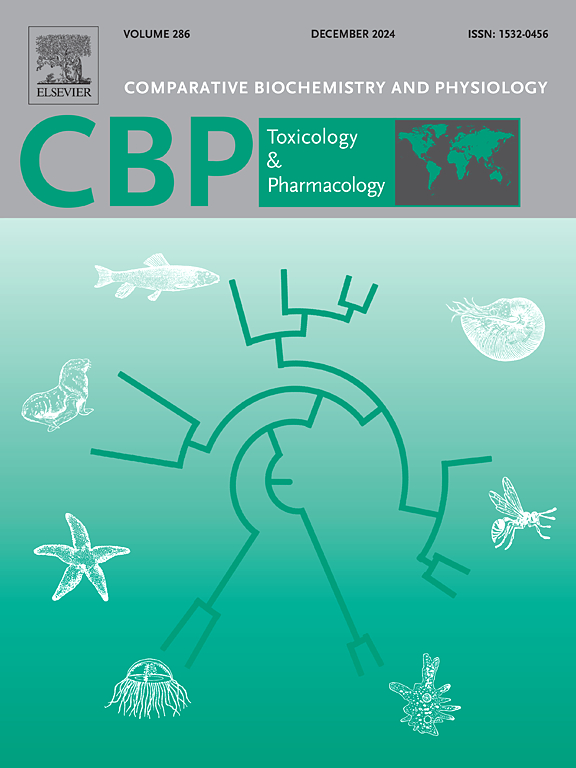Assessing the toxicity of bongkrekic acid in zebrafish embryos
IF 4.3
3区 环境科学与生态学
Q2 BIOCHEMISTRY & MOLECULAR BIOLOGY
Comparative Biochemistry and Physiology C-toxicology & Pharmacology
Pub Date : 2025-05-26
DOI:10.1016/j.cbpc.2025.110235
引用次数: 0
Abstract
Bongkrekic acid (BA) is a potent bacterial toxin found in certain fermented foods, which poses a serious risk to human health through rapid multi-organ failure. Its toxic effects on the early stage of vertebrates remain poorly understood. In this study, we addressed this gap using zebrafish embryos as a model to evaluate BA's developmental toxicity. Following 96-h exposure to BA at concentrations of 0.01, 0.05, 0.1, and 1 mg/L, mortality rates increased sharply between 0.05 mg/L (25 %) and 0.1 mg/L (79 %). Morphological assessments at BA concentrations ≥0.1 mg/L revealed significant reductions in body length, eye and lens areas, and otic vesicle and otolith areas, as well as an enlarged yolk sac, indicating disrupted development and impaired nutrient utilization. Concentrations of BA of ≥0.05 mg/L induced bradycardia, hypo-contractility, and a larger ventricular volume, indicative of cardiotoxicity. BA at ≥0.05 mg/L reduced response rates in sensorimotor assessments and decreased neuromast hair cell numbers, suggesting neurobehavioral impairment. BA at ≥0.1 mg/L also induced hepatotoxicity, marked by reductions in liver area and EGFP fluorescence, along with signs of metabolic acidosis. Additionally, reductions in the mitochondrial-rich ionocyte density at ≥0.1 mg/L suggested compromised ion regulation. A histopathological examination revealed damage to critical organs, including the brain, eyes, and liver. These findings illustrate BA's multifaceted toxicity in embryos, impacting cardiac, neurobehavioral, liver metabolic, and ion regulatory functions.

苯丙酸对斑马鱼胚胎的毒性评估
Bongkrekic acid (BA)是在某些发酵食品中发现的一种强效细菌毒素,它通过快速多器官衰竭对人体健康构成严重威胁。它对早期脊椎动物的毒性作用仍然知之甚少。在本研究中,我们利用斑马鱼胚胎作为模型来评估BA的发育毒性。在暴露于浓度为0.01、0.05、0.1和1mg /L的BA 96小时后,死亡率在0.05 mg/L(25%)和0.1 mg/L(79%)之间急剧上升。BA浓度≥0.1 mg/L时,体长、眼和晶状体面积、耳囊和耳石面积显著减少,卵黄囊增大,发育中断,营养利用受损。BA浓度≥0.05 mg/L可引起心动过缓、收缩力减退、心室容积增大,提示心脏毒性。≥0.05 mg/L的BA降低了感觉运动评估的反应率,减少了神经肥大毛细胞数量,提示神经行为障碍。≥0.1 mg/L的BA也会引起肝毒性,表现为肝面积和EGFP荧光减少,并伴有代谢性酸中毒的迹象。此外,当浓度≥0.1 mg/L时,富线粒体离子细胞密度降低,表明离子调节功能受损。组织病理学检查显示关键器官受损,包括大脑、眼睛和肝脏。这些发现说明了BA对胚胎的多方面毒性,影响心脏、神经行为、肝脏代谢和离子调节功能。
本文章由计算机程序翻译,如有差异,请以英文原文为准。
求助全文
约1分钟内获得全文
求助全文
来源期刊
CiteScore
7.50
自引率
5.10%
发文量
206
审稿时长
30 days
期刊介绍:
Part C: Toxicology and Pharmacology. This journal is concerned with chemical and drug action at different levels of organization, biotransformation of xenobiotics, mechanisms of toxicity, including reactive oxygen species and carcinogenesis, endocrine disruptors, natural products chemistry, and signal transduction with a molecular approach to these fields.

 求助内容:
求助内容: 应助结果提醒方式:
应助结果提醒方式:


